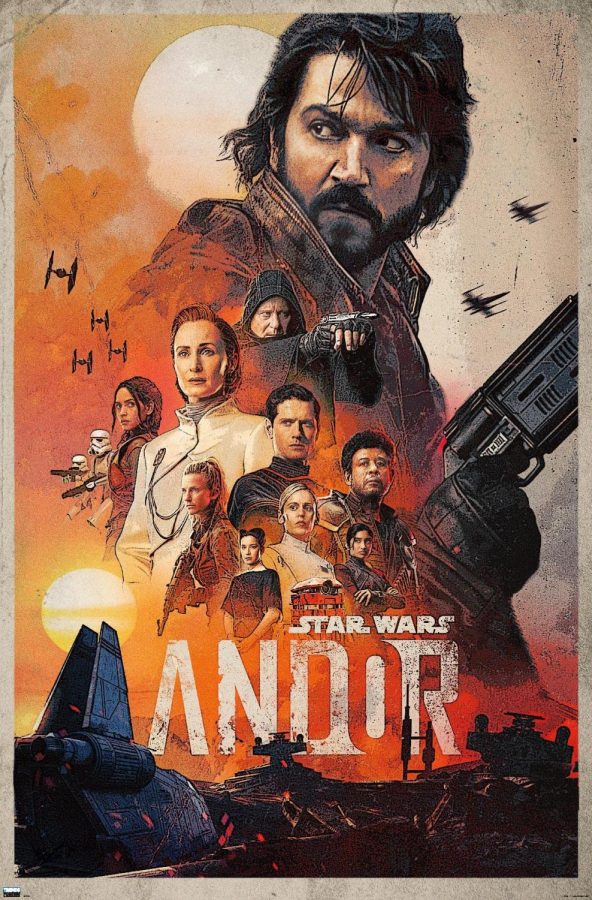Disney flies Star Wars canon to new heights with “Andor”
December 12, 2022
Epic lightsaber duels, cinematic soundtracks and awkward but fan-pleasing dialogue — the Star Wars franchise has long since featured the Skywalkers in nine movies and countless television shows. From George Lucas’s Prequel and Original Trilogy to his “Clone Wars” show, Star Wars has been a fan favorite for decades — revolving around Luke and Anakin Skywalker and their Jedi exploits — until Disney acquired Lucasfilm and the franchise. Disney’s corporate attempt to capitalize on the Skywalker storyline with the release of the sequels was poorly-received for good reason: the fans wanted a change of pace.
Disney took the right direction as they featured less prominent characters in spinoffs. Movies like “Solo” and “Rogue One” painted a gritty depiction of living amid squalor and galactic corruption in contrast to the romanticization of the Jedi order in “The Clone Wars.” Shows like “The Mandalorian” and “The Book of Boba Fett” achieved what the Sequel Trilogy never could: building upon Star Wars’ universe of characters, appeasing longtime fans while maintaining a large audience. Yet, the highly-anticipated “Obi-Wan Kenobi” miniseries was met with mixed reviews as some fans believed the expansion of Kenobi’s story was unnecessary and, worse still, created continuity errors.
Disney’s latest installment, “Andor,” enriches Star Wars’s canonical universe, delving into the sparks of the Rebellion without interfering with the Skywalker plot. The 12-episode show revolves around “Rogue One” protagonist Cassian Andor, the eventual hero and savior of the Rebellion. In contrast to previous Star Wars productions, “Andor” focuses on how ordinary people become revolutionaries rather than centralizing the familiar Jedi and heroes who spearhead the Rebellion. Along the way, “Andor” balances the Rebellion’s complexities with the drudgery of life under the Empire through a cast of nuanced, well-thought-out characters.
New and original characters, such as Karis Nemik, a devoted young revolutionary who envisions an ideal galaxy without the Empire, provide fresh perspectives. In the heist where Andor and his crew steal massive sums of Imperial credits, Nemik captures the revolutionary spirit — dissatisfaction with the corrupt Empire and its displacement of native families from their homeworlds.
Lasting and prominent figures are introduced too, including Luthen Rael, one of the founders of the Rebellion. Introduced to the audience as “The Buyer,” Rael’s mysterious background helps him evade the Empire while hooking the audience, but it clouds the legacy of his contributions. In the same way his efforts go unnoticed by the future Star Wars universe, they elude the fanbase, who weren’t privy to his contributions and character until the release of the show. Novel characters like Rael demonstrate that Star Wars has more to offer beyond action-packed lightsaber fights.
Disney adds another dimension to the politics of the Imperial Senate through the development of Mon Mothma, a character briefly introduced to the franchise in the Original Trilogy. What would seem dull, drawn-out filler between action scenes during Mothma’s political meetings is surprisingly tasteful, as “Andor” maintains suspense as Mothma conceals her Rebellion agenda behind the mask of Imperial politics.
As a whole, “Andor” is Star Wars at its finest. It has given unprecedented depth to the Rebellion’s complexities along with adding to an already richly woven tapestry of characters and stories. Star Wars will hopefully continue weaving this tapestry with its upcoming shows: “Skeleton Crew,” “Lando,” the “Ahsoka” television series, and of course, Season Two of “Andor.”




























































